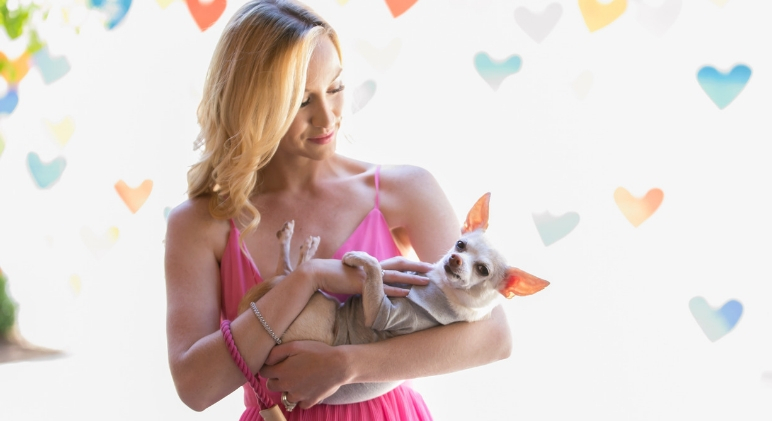There’s a famous quote that says, “Dogs aren’t our whole lives, but they make our lives whole.” As we juggle jobs, life commitments, and hobbies, that statement rings true for many people. But, flip the script and look at it from your dog’s point of view. You are your dog’s whole world. Our canine companions love us unconditionally and wish they could spend every waking minute with us. For many, they experience a level of anxiety when we’re not around. Does this sound like your pup?
I recently interviewed Amber Aquart, a certified animal trainer who’s been training dogs professionally for more than 10 years. Read on for her wisdom and advice on separation anxiety in dogs.
Question: What is separation anxiety?
Amber’s Answer: Separation anxiety is exactly what it sounds like – an animal experiencing anxiety when they’re apart from somebody they’re attached to.
Dogs aren’t the only animal that suffer from this type of anxiety. I also have cats and it’s the same with them. If I’m at home a lot, they start getting really attached and used to their people being home. So, really, any pet can experience it. Dogs, however, do tend to suffer from it most commonly because, as we know, dogs are very attached to their people.
Question: What are some common symptoms?
Amber’s Answer:
- Pacing – This is something you’ll notice if you have a webcam at home and check it when you’re away.
- Destruction – You may come home from an outing to find things ripped up and destroyed.
- Eliminating – Going to the bathroom when you leave the house can be a sign.
- Crying, howling, and barking.
- Avoiding food
There’s really no one-sign-tells-all. Every dog will exhibit symptoms a little differently. The common denominator is when you leave the house and your dog acts in an unusual way (whether your dog will usually eat food and then he doesn’t, or your dog doesn’t usually chew things up and then he does).
Amber’s Story:
One of my dogs started experiencing separation anxiety and had a very unique way of showing it. When I would come home, every single time I would find him locked in the bathroom. He would just be in the bathroom. And I would think to myself: “Wait, did I lock the dog in the bathroom?” It turned out, he would go in the bathroom and close himself in there. That was how he displayed his separation anxiety.

Question: If someone suspects their dog is suffering from anxiety, would you recommend getting a webcam?
Amber’s Answer: Absolutely! Anytime someone reaches out to me for a training consultation, if they suspect separation anxiety, the first thing I suggest is to get a webcam. There’s no way of knowing what’s going on when you’re gone unless you have a webcam. Obviously, if your dog locks himself in the bathroom, you can know something weird is happening. But, you usually don’t get to see these without a webcam.
Question: Is this something you see more with puppies?
Amber’s Answer: Puppies typically have a little bit of separation anxiety, but outgrow it once they get used to a regular routine. That’s because the puppy is being separated from its siblings and put into a place where he/she starts to really rely on their new human. And when the human’s not around, they might not know what to do with themselves.
Adopted rescue dogs also tend to suffer from some separation anxiety, especially when they’re first adopted. I’m sure anyone could understand why. A lot of these dogs have been abandoned in the past. So, they tend to cling on to the person they’re with at the moment. A lot of rescue dogs do, again, outgrow separation anxiety as they start getting more comfortable with their surroundings and familiar with their humans leaving and coming back home.
I also find senior dogs can develop separation anxiety. It’s because, when the dogs get older, their eyesight worsens, they start losing their hearing, and their memory isn’t as sharp as it once was. So, they like someone around.
Question: What about breeds? Are there specific breeds that are more susceptible to separation anxiety?
Amber’s Answer: Yes. Weimaraners are probably the number one leading breed that I get calls about for separation anxiety. A lot of breeds that experience this type of stress were bred to work with people. They’re more dependent. It’s less common in breeds like the Shiba Inu, where they tend to be more independent. But, really, it’s possible with any dog.
Question: Do you anticipate more dogs will experience separation anxiety after we leave quarantine and get back out into the world?
Amber’s Answer: Absolutely. Which is not a good thing, but it’s going to happen. I know it’s already happened with some friends and clients.
Question: What tips do you have for pet parents?
Amber’s Answer: The first step is preventing separation anxiety. A few things you can do before your dog ever shows signs:
- Crate training. Start teaching your dogs to go to their crate and relax. Work your way up to closing the door while you’re on Zoom meetings in the other room.
- Place command. Practice having your dog go to a “place”, like a dog bed, mat, or specific blanket. Have them stay in Place while you move across the room and, eventually, into another room.
- Walks without your dog. It sounds weird, but if your dog is always used to going on walks with you, try going without them. The idea is to spend some time outside while your dog is still inside, whether that be walking around the block or going for a quick drive.
- Puzzles. Practice giving your dog something special when you’re not around. Offering a special treat or KONG when you’re not right next to them will help them feel like you leaving is actually a fun thing.
Question: For dogs already showing signs of anxiety, would you recommend similar steps?
Amber’s Answer: Yes, but in smaller increments.
- Start by practicing Stay. You walk across the room and have your dog stay in his place. Then you go back and give them a treat.
- Let your dog be in a different room for a bit. Start slow — close the door between you and your dog, and then going back and give him a treat.
- Eventually, go for some short walks without your dog and follow the tips above.
Question: When is it time to get help from a trainer?
Amber’s Answer: Separation anxiety can be really serious, and you never want to wait for it to get out of control before calling a trainer. If you get help early on, you can improve it quickly. But, if you wait until your dog is destroying things or eliminating in the house every single time you leave, the training process is longer and much harder.
Keep in mind, if you just got a puppy and they cry when you put them in the crate, that’s pretty normal behavior. But, if you’re noticing something that’s not normal for your dog, or for their age, consider reaching out to a trainer … even if it’s just to ask a question. I know a lot of trainers, myself included, who are doing online consults right now. You might even want to schedule a 30-minute call just to get clarification from a trainer — find out if it’s serious or what’s recommended for your dog’s unique situation.
A Little About Amber

Amber Aquart is a certified animal trainer who has been professionally training dogs for over 10 years. She started her career working as an exotic animal handler and trainer before becoming a professional dog trainer in 2011. She has worked with thousands of pet dogs, rehabbed aggressive dogs, and trained service dogs over the years. Amber started her own off-leash hiking-training company that specialized in helping pet parents get off-leash reliability with their own dogs. Amber and her dogs have been featured on Animal Planet, The Dodo, and Good Morning America. She now has two cats who have helped her expand her training to cats as well.
Amber’s mission is to help pet parents have the best lives possible with relationship-based training techniques and pet lifestyle tips.








